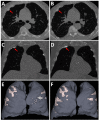Deep Learning for the Automatic Quantification of Pleural Plaques in Asbestos-Exposed Subjects
- PMID: 35162440
- PMCID: PMC8835296
- DOI: 10.3390/ijerph19031417
Deep Learning for the Automatic Quantification of Pleural Plaques in Asbestos-Exposed Subjects
Abstract
Objective: This study aimed to develop and validate an automated artificial intelligence (AI)-driven quantification of pleural plaques in a population of retired workers previously occupationally exposed to asbestos.
Methods: CT scans of former workers previously occupationally exposed to asbestos who participated in the multicenter APEXS (Asbestos PostExposure Survey) study were collected retrospectively between 2010 and 2017 during the second and the third rounds of the survey. A hundred and forty-one participants with pleural plaques identified by expert radiologists at the 2nd and the 3rd CT screenings were included. Maximum Intensity Projection (MIP) with 5 mm thickness was used to reduce the number of CT slices for manual delineation. A Deep Learning AI algorithm using 2D-convolutional neural networks was trained with 8280 images from 138 CT scans of 69 participants for the semantic labeling of Pleural Plaques (PP). In all, 2160 CT images from 36 CT scans of 18 participants were used for AI testing versus ground-truth labels (GT). The clinical validity of the method was evaluated longitudinally in 54 participants with pleural plaques.
Results: The concordance correlation coefficient (CCC) between AI-driven and GT was almost perfect (>0.98) for the volume extent of both PP and calcified PP. The 2D pixel similarity overlap of AI versus GT was good (DICE = 0.63) for PP, whether they were calcified or not, and very good (DICE = 0.82) for calcified PP. A longitudinal comparison of the volumetric extent of PP showed a significant increase in PP volumes (p < 0.001) between the 2nd and the 3rd CT screenings with an average delay of 5 years.
Conclusions: AI allows a fully automated volumetric quantification of pleural plaques showing volumetric progression of PP over a five-year period. The reproducible PP volume evaluation may enable further investigations for the comprehension of the unclear relationships between pleural plaques and both respiratory function and occurrence of thoracic malignancy.
Keywords: artificial intelligence; asbestos exposure; pleural plaques.
Conflict of interest statement
The authors declare no conflict of interest.
Figures



Similar articles
-
Pleural plaques in asbestos-exposed workers: reproducibility of a new high-resolution CT visual semiquantitative measurement method.J Thorac Imaging. 2006 Mar;21(1):8-13. doi: 10.1097/01.rti.0000191424.50208.bd. J Thorac Imaging. 2006. PMID: 16538149
-
Two-stage deep learning model for fully automated pancreas segmentation on computed tomography: Comparison with intra-reader and inter-reader reliability at full and reduced radiation dose on an external dataset.Med Phys. 2021 May;48(5):2468-2481. doi: 10.1002/mp.14782. Epub 2021 Mar 16. Med Phys. 2021. PMID: 33595105
-
Artificial intelligence in computed tomography for quantifying lung changes in the era of CFTR modulators.Eur Respir J. 2022 Mar 3;59(3):2100844. doi: 10.1183/13993003.00844-2021. Print 2022 Mar. Eur Respir J. 2022. PMID: 34266943
-
[Follow-up of subjects occupationally exposed to asbestos, what are the objectives, the benefits, and the possible risks?].Rev Mal Respir. 2011 Dec;28(10):1230-40. doi: 10.1016/j.rmr.2011.06.015. Epub 2011 Nov 17. Rev Mal Respir. 2011. PMID: 22152932 Review. French.
-
Low-dose computed tomography screening for lung cancer in people with workplace exposure to asbestos.Lung Cancer. 2019 May;131:23-30. doi: 10.1016/j.lungcan.2019.03.003. Epub 2019 Mar 6. Lung Cancer. 2019. PMID: 31027694 Review.
Cited by
-
Artificial Intelligence-based Quantification of Pleural Plaque Volume and Association With Lung Function in Asbestos-exposed Patients.J Thorac Imaging. 2024 May 1;39(3):165-172. doi: 10.1097/RTI.0000000000000759. Epub 2023 Nov 1. J Thorac Imaging. 2024. PMID: 37905941 Free PMC article.
References
-
- Guidotti T.L., Miller A., Christiani D., Wagner G., Balmes J., Harber P., Brodkin C.A., Rom W., Hillerdal G., Harbut M., et al. Diagnosis and Initial Management of Nonmalignant Diseases Related to Asbestos. Am. J. Respir. Crit. Care Med. 2004;170:691–715. doi: 10.1164/rccm.200310-1436ST. - DOI - PubMed
-
- Laurent F., Tunon de Lara M. Exposure to asbestos. Role of thoracic imagery in screening and follow-up. Rev. Mal. Respir. 1999;16:1193–1202. - PubMed
Publication types
MeSH terms
Substances
LinkOut - more resources
Full Text Sources
Medical
Miscellaneous

